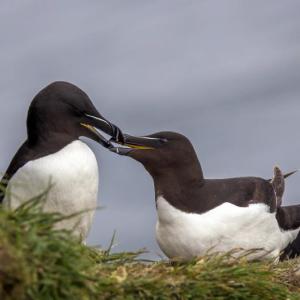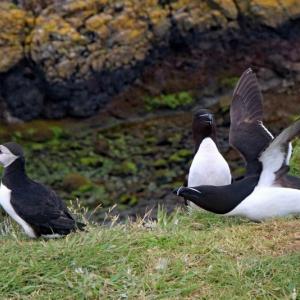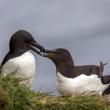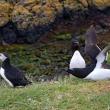The Elegant Puffin Relative, the Razorbill
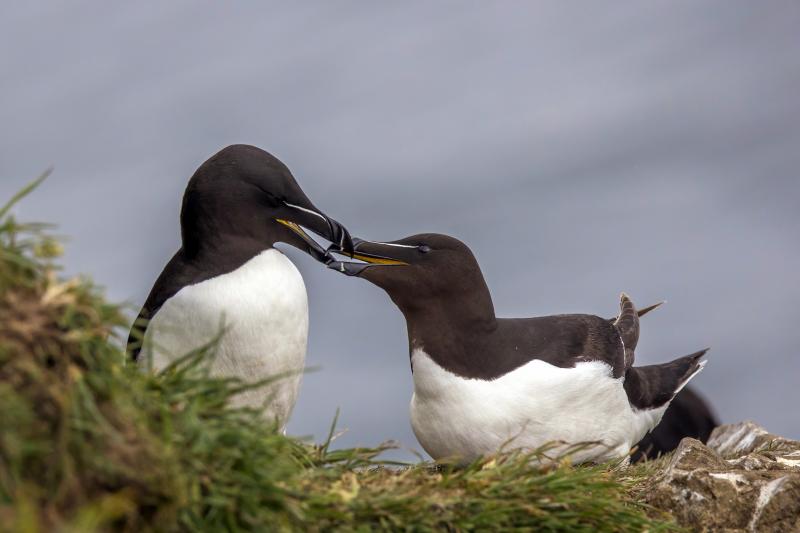 Razorbills are a study in elegant black and white but with bright yellow mouth linings during the breeding season. Photo by Charles J, Sharp under Creative Commons Attribution-Share Alike 4.0 International license courtesy of Wikimedia Commons.
Razorbills are a study in elegant black and white but with bright yellow mouth linings during the breeding season. Photo by Charles J, Sharp under Creative Commons Attribution-Share Alike 4.0 International license courtesy of Wikimedia Commons.
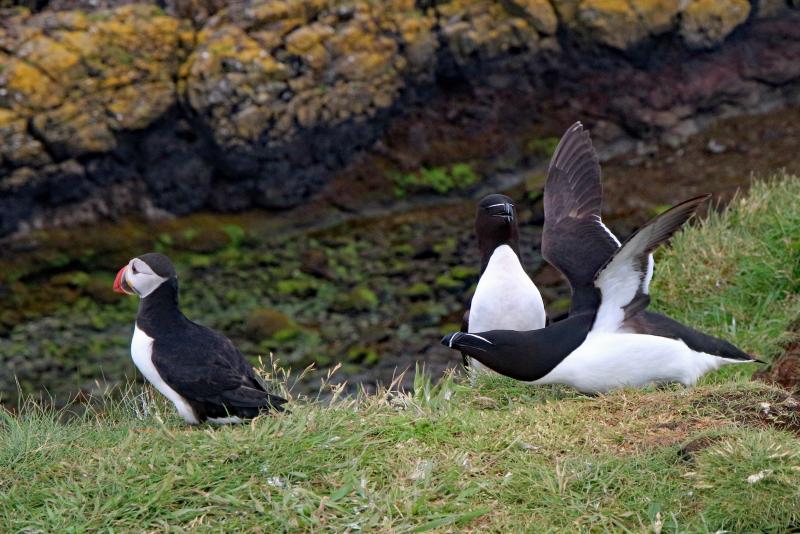 Razorbills don't have the showy orange bills of Atlantic puffins but have many similarities in life history including living in offshore marine habitats and nesting on islands. Photo by Gunther Tschuch under Creative Commons Attribution-Share Alike 4.0 International license courtesy of Wikimedia Commons.
Razorbills don't have the showy orange bills of Atlantic puffins but have many similarities in life history including living in offshore marine habitats and nesting on islands. Photo by Gunther Tschuch under Creative Commons Attribution-Share Alike 4.0 International license courtesy of Wikimedia Commons.
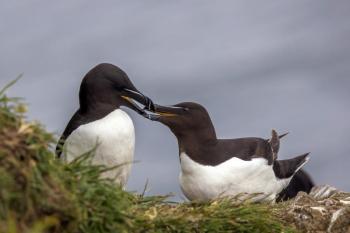 Razorbills are a study in elegant black and white but with bright yellow mouth linings during the breeding season. Photo by Charles J, Sharp under Creative Commons Attribution-Share Alike 4.0 International license courtesy of Wikimedia Commons.
Razorbills are a study in elegant black and white but with bright yellow mouth linings during the breeding season. Photo by Charles J, Sharp under Creative Commons Attribution-Share Alike 4.0 International license courtesy of Wikimedia Commons.
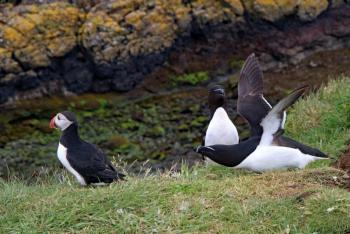 Razorbills don't have the showy orange bills of Atlantic puffins but have many similarities in life history including living in offshore marine habitats and nesting on islands. Photo by Gunther Tschuch under Creative Commons Attribution-Share Alike 4.0 International license courtesy of Wikimedia Commons.
Razorbills don't have the showy orange bills of Atlantic puffins but have many similarities in life history including living in offshore marine habitats and nesting on islands. Photo by Gunther Tschuch under Creative Commons Attribution-Share Alike 4.0 International license courtesy of Wikimedia Commons.
Once or twice a summer, we have the good fortune of riding on the Hardy Boat out of New Harbor, Maine, to Eastern Egg Rock, five miles offshore. The stars of the show are, of course, the Atlantic puffins that were reintroduced to the island by the National Audubon Society after more than a hundred years of absence. Now there is a thriving population of puffins nesting there, delighting thousands of visitors that take the Hardy Boat from New Harbor or a Cap’n Fish’s boat from Boothbay Harbor out on daily trips.
One of the other cool birds that we have seen on a number of our trips out to Eastern Egg Rock is a bird with a cool name: Razorbill.
The razorbill is actually a relative of the puffin, a species of the Alcidae family. Like the Atlantic puffin, the razorbill is dressed elegantly in black and white. Unlike the puffin, its bill is long and thick rather than triangular and without any fancy colors—at least on the outside. When a breeding adult opens its bill, however, it shows a flash of bright yellow on the inside of its mouth. The birds apparently show this yellow mouth lining in aggressive interactions with other razorbills at the nesting colonies.
Like the puffin, the razorbill is a marine species that spends most of its time far offshore. It was known to historically breed on islands off the Maine coast but was wiped out by hunting. The species was confirmed breeding again in the 1960s on Matinicus Rock. Numbers have slowly increased so that the species is now known to breed on at least six islands in the Gulf of Maine, with at least 400 nests on Matinicus Rock in 2018.
Maine is the southernmost place on this side of the Atlantic where the razorbill breeds. The range extends north into the Canadian eastern Arctic, Greenland, and Iceland, and from Scandinavia and western Arctic Russia south to northern France.
Like the puffin, the razorbill takes 4-5 years to reach breeding age, lays only one egg every year, and generally lives to be decades old. One aspect of the life history of the razorbill as compared to the puffin is that razorbill chicks leave the nest at a much earlier age, when their wing and tail feathers are completely undeveloped—less than three weeks after hatching. Puffin chicks, in contrast, don’t leave the nest until 5-6 weeks of age. The male razorbill attends his young chick for the next two months at sea until it can feed on its own.
A few razorbills seem to be attracted to the puffin colony at Eastern Egg Rock every summer but so far, the species has not been found to nest there. Still, it is exciting for birders to have such a relatively accessible location where it is possible to see these striking birds!
Jeffrey V. Wells, Ph.D., is a Fellow of the Cornell Lab of Ornithology and Vice President of Boreal Conservation for National Audubon. Dr. Wells is one of the nation's leading bird experts and conservation biologists and author of the “Birder’s Conservation Handbook.” His grandfather, the late John Chase, was a columnist for the Boothbay Register for many years. Allison Childs Wells, formerly of the Cornell Lab of Ornithology, is a senior director at the Natural Resources Council of Maine, a nonprofit membership organization working statewide to protect the nature of Maine. Both are widely published natural history writers and are the authors of the popular books, “Maine’s Favorite Birds” (Tilbury House) and “Birds of Aruba, Bonaire, and Curaçao: A Site and Field Guide,” (Cornell University Press).

